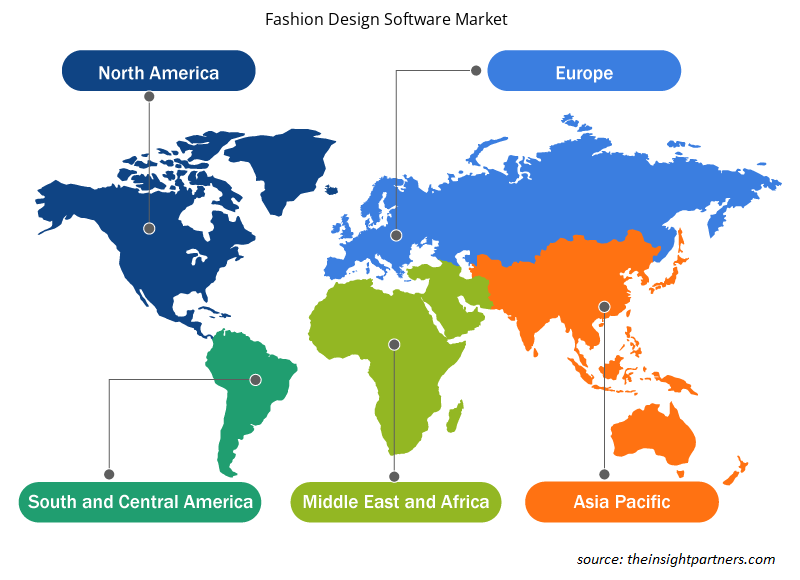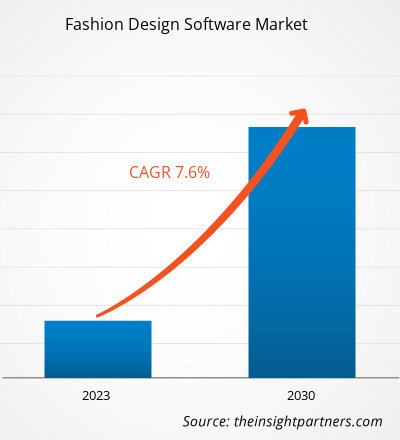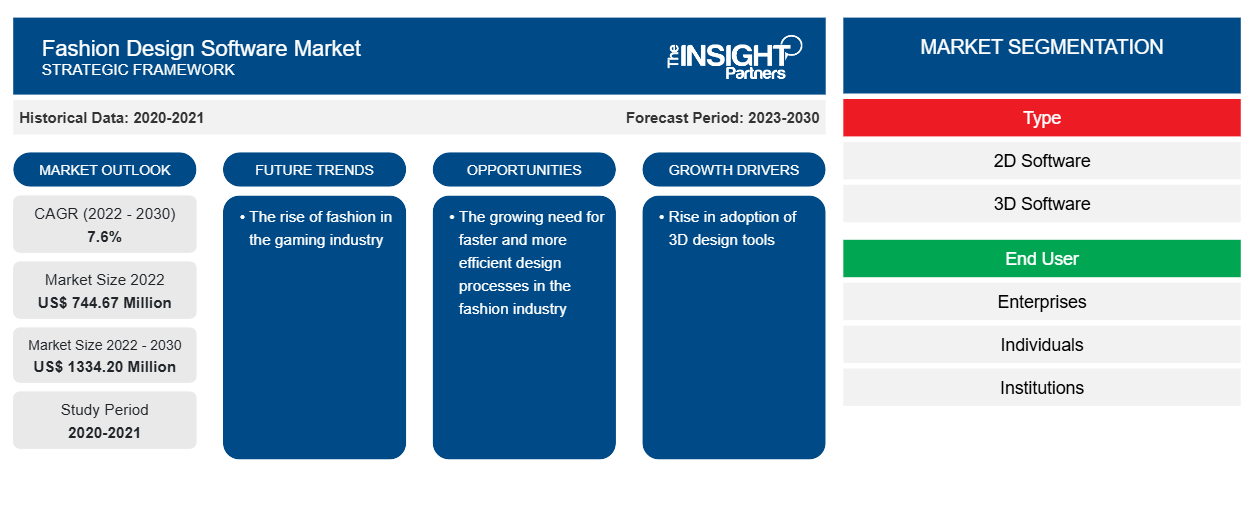من المتوقع أن يصل حجم سوق برامج تصميم الأزياء إلى 1334.20 مليون دولار أمريكي بحلول عام 2030 من 744.67 مليون دولار أمريكي في عام 2022. ومن المتوقع أن يسجل السوق معدل نمو سنوي مركب بنسبة 7.6٪ خلال الفترة 2022-2030. أ. من المرجح أن يظل الارتفاع في اعتماد أدوات التصميم ثلاثية الأبعاد والحاجة المتزايدة إلى عمليات تصميم أسرع وأكثر كفاءة في صناعة الأزياء من الاتجاهات الرئيسية في السوق.
تحليل سوق برامج تصميم الأزياء
إن أحد المحركات الرئيسية لسوق برامج تصميم الأزياء هو الاتجاه المتزايد للتخصيص عند الطلب. ومع تزايد الوعي بالموضة والرغبة المتزايدة في التفرد، يبحث المستهلكون عن قطع ملابس فريدة ومخصصة تعكس شخصيتهم وقيمهم. تمكن برامج تصميم الأزياء المصممين من تقديم خدمات التخصيص، مما يسمح للمشترين بمعاينة مشترياتهم وتخصيصها وفقًا لاحتياجاتهم وتفضيلاتهم المحددة. لقد أطلق اللاعبون في السوق مثل Amazon Fashion وLouoj بالفعل أدوات افتراضية وبرامج تخصيص تصميم ثلاثي الأبعاد، لتلبية الطلب على تجارب الأزياء الشخصية. أحد المحركات الرئيسية هو زيادة اعتماد أدوات التصميم ثلاثية الأبعاد في صناعة الأزياء. يتجه مصممو الأزياء إلى أدوات الرسم المتقدمة CAD مثل Adobe Illustrator وBluecherry وBrowzwear وC-Design Fashion لتحسين عمليات التصميم الخاصة بهم بشكل كبير. تمكن هذه الأدوات المصممين من إنشاء وتصور الملابس رقميًا، مما يقلل من الاعتماد على أخذ العينات المادية والنماذج الأولية. تعمل القدرة على استكشاف اختلافات التصميم المتعددة وتطبيقها على مواد وأنماط مختلفة على تبسيط عملية التصميم وتؤدي إلى تصميمات أكثر ابتكارًا وفرادة.
نظرة عامة على سوق برامج تصميم الأزياء
يؤدي التبني الواسع النطاق لتكنولوجيا تصميم الأزياء إلى تحويل الطريقة التي تستخدمها صناعات الملابس والأزياء والسلع الفاخرة (AF&L) لتصميم وتطوير وتسويق منتجاتها. تعمل برامج تصميم الأزياء على تبسيط عملية تطوير تصميم الأزياء، مما يقلل الوقت والتكلفة بالإضافة إلى التأثير البيئي. يؤدي التحول الرقمي المتزايد في جميع أنحاء العالم إلى تبني حلول برامج تصميم الأزياء.
قم بتخصيص هذا التقرير ليناسب متطلباتك
ستحصل على تخصيص لأي تقرير - مجانًا - بما في ذلك أجزاء من هذا التقرير، أو تحليل على مستوى الدولة، وحزمة بيانات Excel، بالإضافة إلى الاستفادة من العروض والخصومات الرائعة للشركات الناشئة والجامعات
- احصل على أهم اتجاهات السوق الرئيسية لهذا التقرير.ستتضمن هذه العينة المجانية تحليلاً للبيانات، بدءًا من اتجاهات السوق وحتى التقديرات والتوقعات.
محركات وفرص سوق برامج تصميم الأزياء
توسع صناعة الأزياء
إن نمو سوق برامج تصميم الأزياء مدفوع بالاستخدام المتزايد لأدوات التصميم والتقنيات الجديدة، فضلاً عن جهود التوسع في الصناعة. في نوفمبر 2022، توسعت CLO Virtual Fashion إلى باريس، لتضيف إلى مكاتبها الحالية في ميونيخ ومدريد. عززت هذه الخطوة اعتماد تكنولوجيا تصميم الأزياء في مجتمع الأزياء الفرنسي وسمحت بدعم وخدمات أفضل في جميع أنحاء العالم.
تزايد استخدام حلول البرمجيات في الدول النامية
تتبنى الشركات حلولاً متقدمة تكنولوجيًا وتجد طرقًا جديدة للتواصل مع عملائها. ولهذا السبب، تتجه نحو التصميم ثلاثي الأبعاد. ويشكل التصميم ثلاثي الأبعاد جوهر العديد من التطورات التكنولوجية. وتساعد تقنية التصميم ثلاثي الأبعاد في التمثيل البياني للبيانات الهندسية. كما مكّن ظهور مجموعة واسعة من التطبيقات العملاء من تجربة الملابس على الصورة الرمزية قبل أن يقوم العميل بالشراء. وهذا يساعد في تهدئة أي شكوك أثناء شراء شيء افتراضيًا. كما سمحت برامج تصميم الأزياء بإنشاء منتجات مخصصة، والتي يشار إليها باسم "الموضة حسب الطلب". بالنسبة لدولة مثل الهند، كانت للأزياء دلالات وأغراض متنوعة. ومن المتوقع أن يؤدي التركيز على التعليم الشامل إلى إنشاء طلاب ومصممين أخلاقيين وواعين وقادرين على التفكير خارج الصندوق لحل المشكلات والقضايا الأحدث التي ستجلبها الأوقات القادمة بمساعدة البرنامج.
تقرير تحليل تجزئة سوق برامج تصميم الأزياء
إن القطاعات الرئيسية التي ساهمت في اشتقاق تحليل سوق برامج تصميم الأزياء هي النوع والمستخدم النهائي.
- وفقًا للنوع، ينقسم سوق برامج تصميم الأزياء إلى برامج ثنائية الأبعاد وبرامج ثلاثية الأبعاد. ومن المتوقع أن ينمو قطاع البرامج ثلاثية الأبعاد بأعلى معدل نمو سنوي مركب.
- بحسب المستخدم النهائي، يتم تقسيم السوق إلى شركات وأفراد ومؤسسات. ومن المتوقع أن ينمو قطاع الأفراد بأعلى معدل نمو سنوي مركب.
تحليل حصة سوق برامج تصميم الأزياء حسب المنطقة الجغرافية
ينقسم النطاق الجغرافي لتقرير سوق برامج تصميم الأزياء بشكل أساسي إلى خمس مناطق: أمريكا الشمالية، ومنطقة آسيا والمحيط الهادئ، وأوروبا، والشرق الأوسط وأفريقيا، وأمريكا الجنوبية والوسطى.
استحوذت منطقة أمريكا الشمالية على حصة سوقية كبيرة. تعد المنطقة موطنًا للعديد من شركات تصميم وتصنيع الملابس الناجحة. تقبلت صناعة الملابس في المنطقة بسهولة الوافدين الجدد، ولا توجد أي حواجز للدخول فيما يتعلق بسياسات الحكومة. على سبيل المثال، في 7 مارس 2022، وقعت شركة Nextech الكندية العديد من صفقات التجارة الإلكترونية للواقع المعزز ثلاثية الأبعاد. أعلنت شركة Nextecha الرائدة في توفير تقنيات وخدمات تجربة الواقع المعزز ("AR") عن توقيع العديد من صفقات التجارة الإلكترونية للواقع المعزز ثلاثية الأبعاد عبر العديد من الصناعات، بما في ذلك تلك الجديدة على Nextech، مما أدى إلى توسيع نطاق الشركة بشكل أكبر في مساحة النمذجة ثلاثية الأبعاد للتجارة الإلكترونية .
رؤى إقليمية حول سوق برامج تصميم الأزياء
لقد قام المحللون في Insight Partners بشرح الاتجاهات والعوامل الإقليمية المؤثرة على سوق برامج تصميم الأزياء طوال فترة التوقعات بشكل شامل. يناقش هذا القسم أيضًا قطاعات سوق برامج تصميم الأزياء والجغرافيا في جميع أنحاء أمريكا الشمالية وأوروبا ومنطقة آسيا والمحيط الهادئ والشرق الأوسط وأفريقيا وأمريكا الجنوبية والوسطى.

- احصل على البيانات الإقليمية المحددة لسوق برامج تصميم الأزياء
نطاق تقرير سوق برامج تصميم الأزياء
| سمة التقرير | تفاصيل |
|---|---|
| حجم السوق في عام 2022 | 744.67 مليون دولار أمريكي |
| حجم السوق بحلول عام 2030 | 1334.20 مليون دولار أمريكي |
| معدل النمو السنوي المركب العالمي (2022 - 2030) | 7.6% |
| البيانات التاريخية | 2020-2021 |
| فترة التنبؤ | 2023-2030 |
| القطاعات المغطاة | حسب النوع
|
| المناطق والدول المغطاة | أمريكا الشمالية
|
| قادة السوق وملفات تعريف الشركات الرئيسية |
|
كثافة اللاعبين في سوق برامج تصميم الأزياء: فهم تأثيرها على ديناميكيات الأعمال
يشهد سوق برامج تصميم الأزياء نموًا سريعًا، مدفوعًا بالطلب المتزايد من المستخدم النهائي بسبب عوامل مثل تفضيلات المستهلك المتطورة والتقدم التكنولوجي والوعي المتزايد بفوائد المنتج. ومع ارتفاع الطلب، تعمل الشركات على توسيع عروضها والابتكار لتلبية احتياجات المستهلكين والاستفادة من الاتجاهات الناشئة، مما يؤدي إلى زيادة نمو السوق.
تشير كثافة اللاعبين في السوق إلى توزيع الشركات أو المؤسسات العاملة في سوق أو صناعة معينة. وهي تشير إلى عدد المنافسين (اللاعبين في السوق) الموجودين في مساحة سوق معينة نسبة إلى حجمها أو قيمتها السوقية الإجمالية.
الشركات الرئيسية العاملة في سوق برمجيات تصميم الأزياء هي:
- شركة أدوبي
- شركة أوتومتركس
- براوزوير سوليوشنز المحدودة
- CLO Virtual Fashion LLC
- ليكترا إس إيه
- دار هاربر أرينجتون للنشر
إخلاء المسؤولية : الشركات المذكورة أعلاه ليست مرتبة بأي ترتيب معين.

- احصل على نظرة عامة على أهم اللاعبين الرئيسيين في سوق برامج تصميم الأزياء
أخبار سوق برامج تصميم الأزياء والتطورات الأخيرة
يتم تقييم سوق برامج تصميم الأزياء من خلال جمع البيانات النوعية والكمية بعد البحث الأولي والثانوي، والتي تتضمن منشورات الشركات المهمة وبيانات الجمعيات وقواعد البيانات. فيما يلي بعض التطورات في سوق برامج تصميم الأزياء:
- أعلنت هيئة الأزياء السعودية عن إطلاق برنامج جديد لتصميم الأزياء الرقمية بالشراكة مع معهد مارانغوني المرموق. ويركز البرنامج الذي يستمر خمسة أشهر على تعليم المصممين كيفية استخدام برنامج تصميم الأزياء الرقمي CLO 3D، والذي يسمح بإنشاء ملابس وإكسسوارات افتراضية وواقعية. (المصدر: شبكة العربية، بيان صحفي، يناير 2022)
تقرير سوق برامج تصميم الأزياء والتغطية والمخرجات
يوفر تقرير "حجم سوق برامج تصميم الأزياء والتوقعات (2020-2030)" تحليلاً مفصلاً للسوق يغطي المجالات التالية:
- حجم سوق برامج تصميم الأزياء وتوقعاته على المستويات العالمية والإقليمية والوطنية لجميع قطاعات السوق الرئيسية التي يغطيها النطاق
- اتجاهات سوق برامج تصميم الأزياء، بالإضافة إلى ديناميكيات السوق مثل المحركات والقيود والفرص الرئيسية
- تحليل مفصل لقوى PEST/Porter الخمس وSWOT
- تحليل سوق برامج تصميم الأزياء الذي يغطي اتجاهات السوق الرئيسية والإطار العالمي والإقليمي واللاعبين الرئيسيين واللوائح والتطورات الأخيرة في السوق
- تحليل المشهد الصناعي والمنافسة الذي يغطي تركيز السوق، وتحليل خريطة الحرارة، واللاعبين البارزين، والتطورات الأخيرة في سوق برامج تصميم الأزياء
- ملفات تعريف الشركة التفصيلية
- التحليل التاريخي (سنتان)، سنة الأساس، التوقعات (7 سنوات) مع معدل النمو السنوي المركب
- تحليل PEST و SWOT
- حجم السوق والقيمة / الحجم - عالمي، إقليمي، بلد
- الصناعة والمنافسة
- مجموعة بيانات إكسل
التقارير الحديثة
تقارير ذات صلة
شهادات العملاء
سبب الشراء
- اتخاذ قرارات مدروسة
- فهم ديناميكيات السوق
- تحليل المنافسة
- رؤى العملاء
- توقعات السوق
- تخفيف المخاطر
- التخطيط الاستراتيجي
- مبررات الاستثمار
- تحديد الأسواق الناشئة
- تحسين استراتيجيات التسويق
- تعزيز الكفاءة التشغيلية
- مواكبة التوجهات التنظيمية























 احصل على عينة مجانية ل - سوق برامج تصميم الأزياء
احصل على عينة مجانية ل - سوق برامج تصميم الأزياء